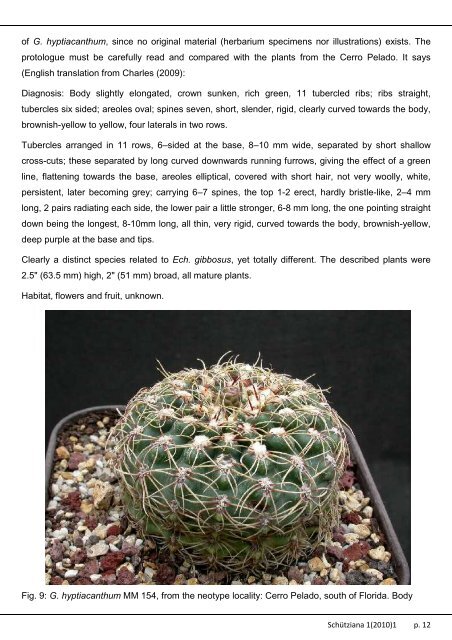Volume 1, Issue 1, 2010 ISSN 2191-3099 - Schütziana
Volume 1, Issue 1, 2010 ISSN 2191-3099 - Schütziana
Volume 1, Issue 1, 2010 ISSN 2191-3099 - Schütziana
Create successful ePaper yourself
Turn your PDF publications into a flip-book with our unique Google optimized e-Paper software.
of G. hyptiacanthum, since no original material (herbarium specimens nor illustrations) exists. The<br />
protologue must be carefully read and compared with the plants from the Cerro Pelado. It says<br />
(English translation from Charles (2009):<br />
Diagnosis: Body slightly elongated, crown sunken, rich green, 11 tubercled ribs; ribs straight,<br />
tubercles six sided; areoles oval; spines seven, short, slender, rigid, clearly curved towards the body,<br />
brownish-yellow to yellow, four laterals in two rows.<br />
Tubercles arranged in 11 rows, 6–sided at the base, 8–10 mm wide, separated by short shallow<br />
cross-cuts; these separated by long curved downwards running furrows, giving the effect of a green<br />
line, flattening towards the base, areoles elliptical, covered with short hair, not very woolly, white,<br />
persistent, later becoming grey; carrying 6–7 spines, the top 1-2 erect, hardly bristle-like, 2–4 mm<br />
long, 2 pairs radiating each side, the lower pair a little stronger, 6-8 mm long, the one pointing straight<br />
down being the longest, 8-10mm long, all thin, very rigid, curved towards the body, brownish-yellow,<br />
deep purple at the base and tips.<br />
Clearly a distinct species related to Ech. gibbosus, yet totally different. The described plants were<br />
2.5" (63.5 mm) high, 2" (51 mm) broad, all mature plants.<br />
Habitat, flowers and fruit, unknown.<br />
Fig. 9: G. hyptiacanthum MM 154, from the neotype locality: Cerro Pelado, south of Florida. Body<br />
<strong>Schütziana</strong> 1(<strong>2010</strong>)1 p. 12



